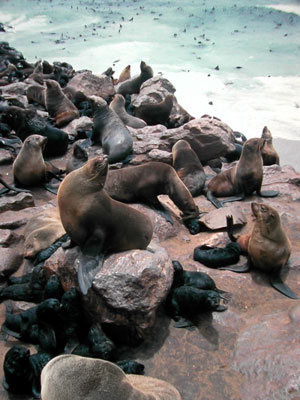| New Photos | Animal News | Animal Sounds | Animal Movies | Upload Photo | Copyright | Korean |
|---|
| Funny Animal Photos | Monsters in Animalia | Wiki Articles Fun Facts about Animals | Links | Home | Mobile A.P.A. |
|---|
| Image Info | Original File Name: South African or Cape fur seals (Arctocephalus pusillus pusillus).jpg Resolution: 300x400 File Size: 38147 Bytes Upload Time: 2007:12:21 15:17:38 | |
| Author | Name (E-mail): Unknown | |
| Subject | Fur Seals (part of Family: Otariidae) - Wiki | |
 |
| Email : E-Card | Poster | Web Master Delete Edit Info Admin |
| Description | Fur Seals (part of Family: Otariidae) - Wiki
Fur seal
Fur seals refers to nine species of pinnipeds in the eared seal (Otariidae) family which also includes the sea lions. A sole species in the Callorhinus genus (the northern fur seal) inhabits the North Pacific, while seven species in the Arctocephalus genus are found primarily in the Southern hemisphere. They are marked by their dense underfur in contrast to the coarse and sparse guard hairs of the sea lions. Taxonomy Until recently, fur seals were all grouped under a single subfamily called Arctocephalinae based on the most prominent common feature between all species, namely the coat of dense underfur intermixed with guard hairs. Recent genetic evidence, however, suggests that Callorhinus is more closely related to some sea lion species, and the fur seal/sealion subfamily distinction has been eliminated from most taxonomies. Nonetheless, all fur seals have certain features in common: the fur, generally smaller sizes, farther and longer foraging trips, smaller and more abundant prey items, great sexual dimorphism and a history of commercial exploitation. For these reasons, the distinction remains useful. Physical appearance Fur seals share with other otariids the ability to turn their rear limbs forward and move on all fours. Fur seals are generally smaller than sea lions - at under 1 m, the Galapagos fur seal is the smallest of all pinnipeds. However, their flippers tend to be proportionately longer, their pelage tends to be darker and the vibrissae more prominent. Males are often more than five times heavier than the females, making them among the most sexually dimorphic of all mammal groups. Behavior and ecology Fur seals gather in large herds once a year to breed on beaches or rocky outcrops. While the northern fur seal males will aggressively defend their harems. After giving birth, females go on extended foraging trips, sometimes up to a week, returning to the rookery to feed their pups until they are weaned. Fur seals are carnivorous, feeding on fish, squid and krill. They are preyed upon by sharks, killer whales, and occasionally larger sea lions. Exploitation Many fur seal species were heavily exploited by commercial sealers, especially during the 19th century when their fur was highly valued. Many populations, notably the Guadalupe fur seal, northern fur seal and Cape fur seal, suffered dramatic declines and are still recovering. Currently, most species are protected and hunting is mostly limited to subsistence harvest. Globally, most populations can be considered healthy, mostly due to the fact that they often prefer remote habitats that are relatively inaccessible to humans. Nonetheless, environmental degradation, competition with fisheries and climate change potentially pose threats to some populations. Species Family Otariidae Genus Arctocephalus Antarctic Fur Seal, Arctocephalus gazella Guadalupe Fur Seal, Arctocephalus townsendi Juan Fernandez Fur Seal, Arctocephalus philippii Galapagos Fur Seal, Arctocephalus galapagoensis Cape Fur Seal, Arctocephalus pusillus - South African Fur Seal, Arctocephalus pusillus pusillus - Australian Fur Seal, Arctocephalus pusillus doriferus New Zealand Fur Seal or Southern Fur Seal, Arctocephalus forsteri Subantarctic Fur Seal, Arctocephalus tropicalis South American Fur Seal, Arctocephalus australis Genus Callorhinus Northern Fur Seal, Callorhinus ursinus http://en.wikipedia.org/wiki/Fur_seal
| |||
| Copyright Info | AnimmalPicturesArchive.com does not have the copyright for this image. This photograph or artwork is copyright by the photographer or the original artist. If you are to use this photograph, please contact the copyright owner or the poster. |
|
|
|
| |||||||
| CopyLeft © since 1995, Animal Pictures Archive. All rights may be reserved. | ||||||||
Stats